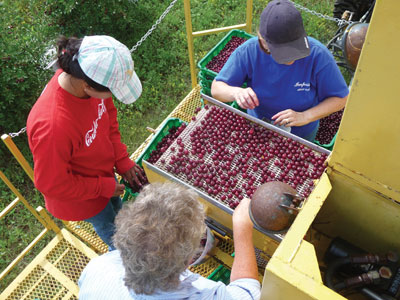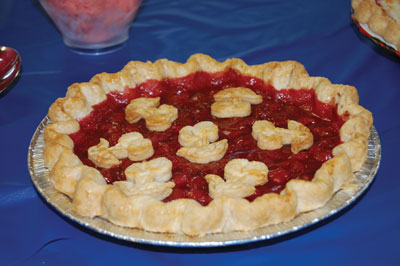
Pucker up
May 29, 2012
By
Stefanie Wallace
A recent survey conducted by Culinary Visions Panel found that sweet and
salty flavours still rank highest among the general population’s
preferred flavour profiles
A recent survey conducted by Culinary Visions Panel found that sweet and salty flavours still rank highest among the general population’s preferred flavour profiles. But palates are ever evolving, and more and more foodies are leaning away from traditional sweet treats in favour of bitter, sour and umami (a Japanese word meaning pleasantly savoury) flavours to tingle their tastebuds. With their bold taste, vibrant colour and plentiful benefits for baking (and possibly your health), sour cherries may be able to bridge the gap between the desire for a new experience and the longing for an old faithful ingredient.

|
|
| The University of Saskatchewan has spent years developing several varieties of sour cherries.
|
Known as tart cherries in the United States, the vast majority of the world’s sour cherry production is in Europe, but there are several varieties produced in Canada. According to the 2006 Census of Agriculture, Ontario hosts 84 per cent of Canada’s total sour cherry area. More than 95 per cent of all sour cherries on the market are of the Montmorency variety, with bright red skin and pale flesh. “The colour [of Montmorency cherries] is more vibrant red than black sweet cherries,” says Julianna Pawlowski, retail sales manager at Cherry Lane farm in Vineland Station, Ont.
The University of Saskatchewan has been developing several varieties of sour cherries for years. The Evans variety was developed in the 1950s and produces a lighter-coloured fruit. In the mid-1990s, the university developed a dwarf shrub cherry plant that grows six to eight feet tall, allowing for mechanical harvesting. The Carmine Jewel was the first variety to be introduced in 1999, and the romance series, with varieties including Romeo, Juliette, Valentine, Crimson Passion and Cupid, were released in 2006. “They are very intense in colour, sweetness and flavour,” says Bruce Hill, president of Canadian Cherry Producers Inc. (CCPI), the producer-controlled organization that was started in November 2006 to support the sour cherry industry in the Prairies. “Our production is just beginning on the Prairies now, and it’s not near the scale you’d see in Ontario or Michigan,” he says, noting that Michigan is the largest tart cherry producer in the United States.
“One of the criteria [of being bred in Saskatchewan] was that they had to be a short-season crop,” Hill says. “We haven’t been able to identify diseases or pests right now, because cherry fruit flies don’t like -35 C. That’s quite a benefit to us.” But, like any crop, there are still challenges. “We’re still seeing some problems with dieback in the winter,” Hill says of a soil-borne water mould that causes root rot, which can infect and kill plants.
Regardless of the variety, Pawlowski and Hill agree that sour cherries trump sweet cherries in the baking department.
“Sweet cherries don’t cook well and they lose their flavour quite readily,” says Hill. He adds that sour cherries the University of Saskatchewan produces have a very short shelf life, so they are quickly frozen after harvest to stabilize their complex flavour. “A baker will use very little because of the intensity,” he says. “When you think you should use a handful, you should be using half a handful.”
Pawlowski adds that while black sweet cherries are very high in sugar, sour cherries are better for baking because they do not have a high sugar content. “Usually black sweet cherries are used just to eat the way they are,” she says.
Delicious and nutritious?
While there have been no studies proving this, both Pawlowski and Hill say the potential health benefits of sour cherries are great.
“There haven’t been any human trials, but there are different studies that have been done by the University of Michigan on mice and rats to show that it reduces the amount of inflammation due to gout and arthritis,” Pawlowski says. “There’s also melatonin in it as well, which helps to regulate sleeping patterns.”
“We can’t put that on the labels yet,” says Hill, “but because they’re so intense in colour, if the health benefit is related to the colour, they would be very high [in antioxidants].”
But, Pawlowski cautions, cooking sour cherries too much reduces their potential health benefits. “If there’s too much heat involved you lose the health benefits of the cherries,” she says. “You’re better just to drink the water you’re boiling them in.”
Tested until perfect
If the name of her store isn’t a testament to her love of the ingredient, Kyla Eaglesham, owner of Madeleines, Cherry Pie and Ice Cream in Toronto, can quickly tell you some of her favourite ways to incorporate sour cherries into desserts.
 |
|
| Kyla Eaglesham, owner of Madeleines, Cherry Pie and Ice Cream, says ice cream or liqueur will enhance the tart flavour of the pie.
|
“They’re good for saucy desserts: pie, naturally, and cherry streudel . . . don’t tell the apple people, but I think it’s the best in the world!” Eaglesham says. “Sauces are great as well – chocolate cake with a cherry sauce is brilliant,” she gushes. When using the fruit fresh or frozen, Eaglesham reinforces the importance of respecting the pulp in the fruit.
“Because it’s a pulpy fruit, it’s better as a sauce or in something where there’s a vessel of pastry for it,” she says, noting that an almond cake crumbled on top of phyllo pastry gives a sour cherry strudel a great flavour.
A huge advantage for Eaglesham is that there are great varieties of the fruit grown (fairly) close to home. “I think technically, they freeze well,” Eaglesham says. “You can have local fruit in your freezer and pull it out and bake with it.”
Hill adds that dried cherries can be excellent in place of raisins or dried cranberries, and Eaglesham agrees: “We’ve done dried cherries in fudge and dried cherries in biscotti, and they’re both fantastic.”
The varieties grown at the University of Saskatchewan are great for natural food colouring and natural food flavouring for other applications. “A couple of wineries out here are making sour cherry wine. The tartness of these cherries makes an excellent wine,” Hill says.
And cherry concentrate, which is a popular item at Cherry Lane, can be used for doughnut fillings or as a drizzle for ice cream or cheesecake, Pawlowski suggests.
Of course, incorporating such a niche ingredient into your menu calls for lots of development. “[Sour cherries] are highly acidic, so you really need to control your starch to thicken it properly,” Eaglesham says. “Use fresh ingredients always . . . use fresh flour and make sure you’re resourcing your starches from fresh sources.”
Eaglesham has mastered the art of the sour cherry pie, but not without lots of experimentation. “It did take us a while to get the right ratio of flour to thicken it without taking away from the cherries,” she says, noting that flour is her starch of choice over cornstarch. “Another challenge is allowing the natural sugars in the fruit to do what they do,” she advises. “You have to really see your filling boiling; you’ve gotta take your time and let it get to the right temperature.”
When it comes to the flavour of her signature dish, Eaglesham believes that it’s not about balancing the tart flavour with sweetness, but complementing the flavour and letting it shine. “Everyone is schooled differently, but sometimes we think that if it’s tart, we need to add sugar,” she says. “But what I think we need to do is enhance the tartness, and then add ice cream or a liqueur that complements [the flavour] as a beverage beside the plate.”
Eaglesham uses almond liqueur or bitter in her recipes to let the tartness sing, rather than sugar. “In a restaurant showing, I would say a sour cherry tart with a sweet digestif, like amaretto or Frangelico, would be a great dessert pairing.”
She’s certainly doing something right among the male crowd. “Men love sour cherry pie!” she exclaims. “It’s like the red Corvette of the pie world,” she says with a giggle. “So many people will come in and say my uncle loves cherry pie, or this is for my dad. I don’t know why it is – and not to exclude the women – but it’s a very familiar “dad” thing for a lot of people.”
And the demand for it is great. “Fortunately we haven’t had any big problems, where there was either a surplus or shortage,” Eaglesham says. She finds the ingredient to be fairly economical. “Apples are the most cost effective, but if you want to compare plums, peaches, blueberries and cherries, they all have their seasons and they all sit in a nice comfort zone that you can price your products at,” she says. At Cherry Lane, sour cherries aren’t as pricey as their sweet counterpart: a 30-pound bag of frozen sour cherries retails for $43, and a 22-pound bag of frozen sweet cherries retails for $42.
Whether you call them sour or tart, or use them fresh, frozen or dried, the bold flavour and vibrant colour of sour cherries may be just what you need to add a little extra oomph to your desserts.
Print this page
Leave a Reply